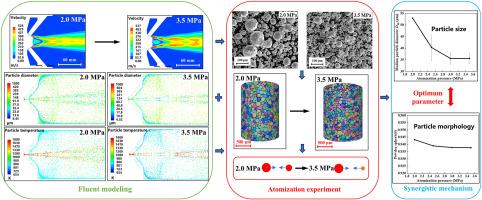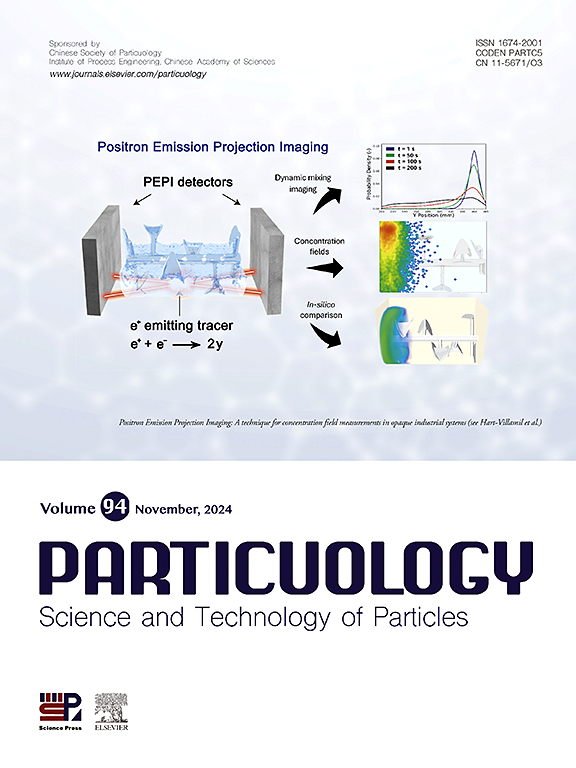用于增材制造的超级合金粉中粒度和形态的协同影响机制
IF 4.1
2区 材料科学
Q2 ENGINEERING, CHEMICAL
引用次数: 0
摘要
超耐热合金粉末的粒度和形态是显著影响增材制造(AM)工艺性能的关键参数。本研究结合计算流体动力学(CFD)模拟和真空感应熔化气体雾化(VIGA)实验,研究了雾化压力对这些特性的影响。CFD 模拟显示,将雾化压力从 2.0 兆帕提高到 3.5 兆帕后,最大气体速度从 526 米/秒提高到 537 米/秒,中值粒径 (D50) 从 60.9 微米减小到 37.5 微米。随后的实验表明,随着压力的增加,D50 从 52.9 μm 降至 35.6 μm,球形度从 0.9432 降至 0.9377。雾化实验和数值模拟的粒度结果显示出很强的一致性,验证了数值模拟结果的准确性。空心颗粒的体积也在特定尺寸分数上略有增加。这些结果表明,较高的雾化压力可产生球形度较低的更细粉末,但同时也会促进颗粒粘附,降低整体细化效果。这项研究为优化雾化条件以精确控制 AM 中的超耐热合金粉末提供了启示。本文章由计算机程序翻译,如有差异,请以英文原文为准。

Synergistic impact mechanism of particle size and morphology in superalloy powders for additive manufacturing
The particle size and morphology of superalloy powders are crucial parameters that significantly influence the performance of additive manufacturing (AM) processes. This study investigates the effects of atomization pressure on these characteristics through a combination of computational fluid dynamics (CFD) simulations and vacuum induction melting gas atomization (VIGA) experiments. The CFD simulations revealed that increasing the atomization pressure from 2.0 MPa to 3.5 MPa resulted in a rise in maximum gas velocity from 526 m/s to 537 m/s and a reduction in median particle size (D50) from 60.9 μm to 37.5 μm. Subsequent experiments demonstrated a decrease in D50 from 52.9 μm to 35.6 μm, and sphericity from 0.9432 to 0.9377, as pressure increased. The particle size results of the atomization experiments and numerical simulations show strong consistency, validating the accuracy of the numerical simulation results. The volume of hollow particles also increased slightly in specific size fractions. These results suggest that higher atomization pressures produce finer powders with lower sphericity, but also promote particle adhesion, reducing the overall refinement effect. This study provides insights into optimizing atomization conditions for the precise control of superalloy powders in AM.
求助全文
通过发布文献求助,成功后即可免费获取论文全文。
去求助
来源期刊

Particuology
工程技术-材料科学:综合
CiteScore
6.70
自引率
2.90%
发文量
1730
审稿时长
32 days
期刊介绍:
The word ‘particuology’ was coined to parallel the discipline for the science and technology of particles.
Particuology is an interdisciplinary journal that publishes frontier research articles and critical reviews on the discovery, formulation and engineering of particulate materials, processes and systems. It especially welcomes contributions utilising advanced theoretical, modelling and measurement methods to enable the discovery and creation of new particulate materials, and the manufacturing of functional particulate-based products, such as sensors.
Papers are handled by Thematic Editors who oversee contributions from specific subject fields. These fields are classified into: Particle Synthesis and Modification; Particle Characterization and Measurement; Granular Systems and Bulk Solids Technology; Fluidization and Particle-Fluid Systems; Aerosols; and Applications of Particle Technology.
Key topics concerning the creation and processing of particulates include:
-Modelling and simulation of particle formation, collective behaviour of particles and systems for particle production over a broad spectrum of length scales
-Mining of experimental data for particle synthesis and surface properties to facilitate the creation of new materials and processes
-Particle design and preparation including controlled response and sensing functionalities in formation, delivery systems and biological systems, etc.
-Experimental and computational methods for visualization and analysis of particulate system.
These topics are broadly relevant to the production of materials, pharmaceuticals and food, and to the conversion of energy resources to fuels and protection of the environment.
 求助内容:
求助内容: 应助结果提醒方式:
应助结果提醒方式:


